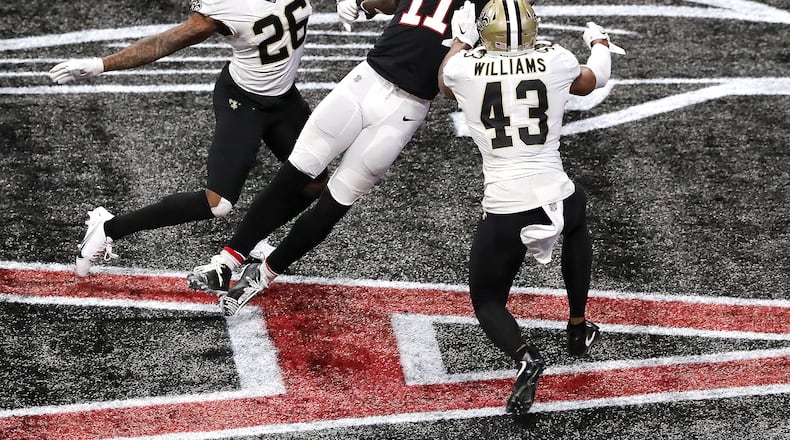With 1:55 remaining in Sunday’s 21-16 loss to the rival New Orleans Saints, the Falcons found themselves in position to potentially complete an unforeseen comeback. It was a stunning development in the moment, considering how the game had otherwise transpired over the first three quarters.
But coming out of the two-minute warning in the fourth quarter, which followed running back Todd Gurley carrying the ball for 8 yards on first down, the Falcons ran three plays for minus-7 yards. Given when these plays occurred, this sequence was illuminated afterward.
On second-and-2, the Falcons were unable to pick up a yard with a carry to Gurley, who both Falcons interim coach Raheem Morris and offensive coordinator Dirk Koetter said was used situationally throughout the game due to his knee injury. Koetter said one of the reasons to run the ball on this particular play was to force the Saints to call their first timeout since they were nearing the goal line and could potentially take the lead. While the Falcons didn’t pick up a first down, they still were in a manageable third-and-short situation.
But it was this play that ultimately set the Falcons back.
On third-and-2 from the Saints 13-yard line, Koetter called a running play to Gurley, with left tackle Jake Matthews and left guard Justin McCray tasked with double teaming defensive tackle David Onyemata. Tight end Hayden Hurst, lined up to the right, came across the formation to complete a block on the left side of the line. However, Onyemata was able to get into the Falcons’ backfield and make contact with Hurst, which disrupted his timing on being able to reach Saints defensive end Carl Granderson for the block. Gurley was forced to try to run away from defenders but ended up corralled for a 7-yard loss.
“We had penetration that knocked the tight end who was cross blocking and knocked him off his block coming across,” Koetter said. “And then Todd was trying to cut it back and then he tried to bounce it back. And it ended up being bad. That blocking scheme had been our best run play. We probably ran it four or five times in the second half and it had been our best play. It certainly wasn’t on that play.”
That play led to an unexpected fourth-and-9 from the 20-yard line. As the play unfolded, quarterback Matt Ryan looked to be targeting receiver Julio Jones, who ran to the end zone from the slot, the entire way, even while drawing double coverage. As Jones broke his route to the left, the ball arrived to his right. This forced the star receiver to bend his body backward to try to bring the ball in with one hand with two defenders on each side of him.
Jones was unable to do so, with the ball falling incomplete on fourth down.
However, receiver Russell Gage beat cornerback Chauncey Gardner-Johnson on a slant to the inside. Although Gage was running a short route underneath, he was open and appeared to have some space in front of him to potentially pick up the first down.
“I think (Ryan’s) thinking, ‘We may not get another shot at this and I better give Julio a chance in the end zone at making a touchdown,’” Koetter said. “That’s what he did. It’s debatable if he throws it to (Gage) at 5 yards -- he is open. Does he gain enough yardage to get the first down? That’s hard to say.”
The Falcons’ offense struggled to find consistency in both meetings against the Saints this year. Through the first seven quarters combined in those two games, the Falcons were held without a touchdown. They finally scored one in the fourth quarter -- a 10-yard touchdown throw from Ryan to Gage -- that ended the slump.
As was the case in the first meeting, the Falcons relied heavily on place-kicker Younghoe Koo in the first half with three field goals. This year, red zone efficiency has been an issue as the Falcons rank 29th in the league at only converting 50% of their trips inside the 20-yard line into touchdowns. While Koo’s first field goal was from 53 yards, his next two -- from 30 and 28 yards out -- came after reaching the red zone.
With the way the Saints defended the Falcons two weeks ago, and with how much of the second game went, Morris said it was clear the offense didn’t do enough to correct the issues that were present from the first game.
“I’d be telling you a story if I said we made the necessary adjustments when you come out and lose,” Morris said. “That would be the wrong approach, in my opinion. When you come out and you have a slow start in the first half, you’re certainly disappointed in what you did on offense and you’re certainly disappointed in those things. We kicked too many field goals. Koo has been money but I’d like to see less of him. We like to score touchdowns.”
About the Author
Keep Reading
The Latest
Featured
